Of Historians and Their Words:
Eras, Concepts, Dates, Ages....
In Our Search for Meaning,
We Settle on the Terms
'Renaissance' and 'Reformation'
Historical understanding consists of perceiving differences
among similar phenomena and similarities among different ones.
— Raymond Aron (1959)
By Ronald Fritze
Posted on January 9, 2012, from Athens, Alabama
Everyone has heard or read the terms “Renaissance” and “Reformation” being used in lectures and books. Both terms are familiar but what do they really mean or stand for?
Renaissance means “rebirth.” That begs the question of a “rebirth” of what? More on that later. It also begs the question of when was the Renaissance? In the strictest sense, historians define the time period of the Renaissance as comprising the late fourteenth, the fifteenth, and the early sixteenth centuries in European (especially Italian) history. A textbook by one of the leading experts in the field uses the date of 1300-1517. Another textbook, however, defines the time period more as 1453-1517.
The great city of Constantinople fell in 1453, while 1517 is the year that Luther produced the 95 theses that began the Reformation. Other books take the Renaissance into the late sixteenth and seventeenth centuries, particularly for purposes of literary history, e.g., William Shakespeare (1564-1616) lived in the latter part of the sixteenth century and into the early seventeenth century and is thought to have flourished toward the early years of the English literary Renaissance.
A Cloudy Issue of Differences
The dates of our course, 1350-1610, conform to some of these concepts of the Renaissance but not others. Giotto (1266?-1337), the father of Renaissance painting, lived well before 1350. Some argue that the Reformation brought the Renaissance to an end, but Shakespeare, Michel de Montaigne, and John Milton all lived well after the Reformation and can be considered Renaissance writers.
The fact is, the Renaissance flourished in different places during difference periods of times — and it flourished in different ways. That clouds the issue of when the Renaissance occurred.
Another problem is whether the cultural revival of the Renaissance was all that unique or significant. Some historians point
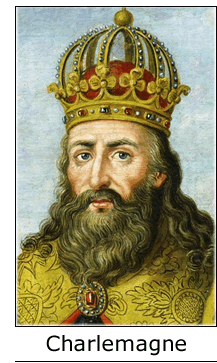 out that there were earlier renaissances or revivals of culture that were equally important. The renaissance of the Carolingian period during the reign of Charlemagne in the early medieval period has been closely studied. Even more significant is the renaissance of the twelfth century that the medievalist Charles Homer Haskins brought to prominence.
out that there were earlier renaissances or revivals of culture that were equally important. The renaissance of the Carolingian period during the reign of Charlemagne in the early medieval period has been closely studied. Even more significant is the renaissance of the twelfth century that the medievalist Charles Homer Haskins brought to prominence.
For many historians the term “renaissance” does not denote a unique period in European history but can be used as a label for to define any period of “intellectual or aesthetic vigor that follows a period of cultural quiescence or decline.” Renaissance scholars still continue to define the term in spite of these attacks from other historians and the innate vagueness of the term itself. One reason for this defense is that the concept of the Renaissance is too ingrained in the thought and writing of historians and the popular imagination to be abandoned. A second reason is that the term and periodization does have some genuine validity.
Febvre Claims Michelet Did It
How did the idea of the “Renaissance” get started? The famous twentieth-century French historian Lucien Febvre claimed that the nineteenth-century romantic French historian Jules Michelet (1798-1874) invented the term “renaissance” as an identifier for the very beginning of what is now called the Renaissance era. But the term goes back much further than Febvre claimed. It goes back to the very beginning of the Renaissance era.
During the fourteenth century, the Italian scholar Francesco Petrarch (1304-1374) led a renewal of interest in classical
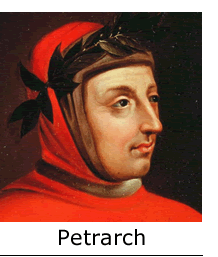 antiquity. Petrarch believed that history consisted of two eras — the ancient or pre-Christian era and the “nova” (modern) or Christian era. This concept is not unique to Petrarch. It goes back to the worldview of the early Christian Church and was popularized by St. Augustine of Hippo. In the view of Petrarch, the ancient era was a period of solid cultural achievement while the modern era, including his own time, was an age of human and cultural decline.
antiquity. Petrarch believed that history consisted of two eras — the ancient or pre-Christian era and the “nova” (modern) or Christian era. This concept is not unique to Petrarch. It goes back to the worldview of the early Christian Church and was popularized by St. Augustine of Hippo. In the view of Petrarch, the ancient era was a period of solid cultural achievement while the modern era, including his own time, was an age of human and cultural decline.
Petrarch longed for a renewal of the glories of classical Greece and Rome. He did not, however, believe it was possible to match the achievements of the ancients. Too much had been lost. Still he lead the search to recover old manuscripts and to revive the standards of ancient literary style.
Thanks to Petrarch and his followers and imitators, progress was made in the recovery of classical knowledge. Confidence increased and some people like Giovanni Boccaccio (1313-1375), a contemporary of Petrarch’s, came to feel more and more that they were living in an epoch of “rebirth,” or as they called it in Italian, “rinascita.”
A Rebirth in the Arts and Literature
 In addition to a recovery of classical literature, there was also an improvement of artistic techniques as Italian artists recovered the skills of perspective and accurate nude painting. Renaissance art strove for realism. The first writer to trace the history of this development and label it “renaissance” or “rinascita” was Giorgio Vasari (1511-1574). His Lives of the Great Painters, Sculptors, and Architects (1550) traces what he saw as the rise and culmination of a movement that he felt was on the verge of collapse in his lifetime.
In addition to a recovery of classical literature, there was also an improvement of artistic techniques as Italian artists recovered the skills of perspective and accurate nude painting. Renaissance art strove for realism. The first writer to trace the history of this development and label it “renaissance” or “rinascita” was Giorgio Vasari (1511-1574). His Lives of the Great Painters, Sculptors, and Architects (1550) traces what he saw as the rise and culmination of a movement that he felt was on the verge of collapse in his lifetime.
It was the great humanist Erasmus (1466?-1536) who firmly attached the term of rebirth to the continuing developments in literary studies and the Classics. At this point, the term of Renaissance was confined to the rebirth of art and literature.
Jules Michelet’s achievement was not to invent the concept of Renaissance but rather to expand it to politics and the entire era in all its aspects. According to Michelet, the Renaissance was a period in which both the world and man were discovered.
The Beginning of the Modern World
Michelet’s concept of the Renaissance was then taken further by the Swiss historian Jacob Burkhardt(1818-1897) in his Civilization of the Renaissance in Italy (1860). According to Burkhardt, the Renaissance was the beginning of the modern world. This era was a time when secularization and modern individualism appeared and took root. Burkhardt’s concepts formed the basis for most further studies of the Renaissance, either as a starting point or point of departure or a position to be attacked by medievalists. It held that place in historical thinking until 1945. Burkhardt’s ideas are still deeply respected by many scholars.
The historian Margaret King in her textbook The Renaissance in Europe (2003) puts forward the concept of three Renaissances — small, medium, and large. The small Renaissance is comprised by the revival of classical forms and ideas. Medievalists object to this view of the Renaissance because they know of the earlier revivals of the Classics. The medium Renaissance views the Renaissance as a broad cultural resurgence and is synonymous with the view of the Renaissance advocated by Jacob Burkhardt. The large Renaissance is the identification of a period of two or three centuries between the Middle Ages and the Modern era in all its aspects: cultural, economy, society, religion, and politics.
Values and Assumptions
It is also important to keep in mind that the use of the term “Renaissance” or “rebirth” has value-laden connotations about different periods of history. There are certain assumptions built into the term.
1) Petrarch felt he lived in a period of decline that needed a rebirth.
2) Petrach’s successors thought they lived in a time of rebirth that they were instrumental in creating. Basically this meant that renaissance men not only invented the concept of the Renaissance, they also invented the concept of the Middle Ages. For them, the Middle Ages were an era of superstition and relative ignorance that occurred between the heights of Classical times and the Renaissance revival of culture and learning.
3) By the sixteenth century and the early seventeenth century, men like Francis Bacon (1561-1626) had begun to develop the idea of human progress. What this development meant was the recognition that scholars were not simply reviving the lost achievements of Classical civilization, they were going beyond it into new discoveries. New inventions made this concept of progress possible, e.g., gunpowder, the printing press, and new navigational tools. The idea of progress, however, did not eliminate the view that the Middle Ages were a dark and unprogressive time. This attitude toward the Middle Ages and the Renaissance prevailed through the age of the Enlightenment during the eighteenth century which also valued individualism and secularization.
4) The Romantic Era of the late eighteenth and early nineteenth centuries challenged the value judgments concerning the positives of the Renaissance and the negatives of the Middle Ages. Romantics valued the Middle Ages as an age of faith and a time of community spirit and control. To them Renaissance individualism and secularization were what was bad about their contemporary society. They lived in the era of the French and the Industrial Revolutions and that affected their thinking.
5) Burkhardt, although a modern historian in his techniques, reflected his own concerns and the concerns of his age in how he interpreted the Renaissance. Burkhardt valued individualism and secularization. He feared the emerging democratic mass culture and the traditional authority of the Church. During his lifetime, mass culture seemed to be on the rise and the authoritarian nature of the Roman Catholic Church was reviving. Therefore, when Burkhardt found what he considered to be individualism and secularism in the fourteenth and fifteenth centuries in Italy, he judged that era to be praiseworthy and the beginning of all that was good in modern civilization, since it exemplified traits that he admired.
6) Burkhardt’s concepts dominated historical writing until after World War I when medievalists started to attack his ideas on a variety of fronts. They emphasized both the genuine achievements of medieval civilization and the continuity between the Middle Ages and the Renaissance. Johann Huizinga (1872-1945), a Dutch historian, particularly saw this continuity between the Middle Ages and the Renaissance and viewed the fifteenth century as an era of decline rather than rebirth in European history.
Unique in Character and Significance
By 1940 the idea of the Renaissance Era, i.e., the fourteenth and fifteenth centuries, still survived, but any agreement as to its nature and character had been lost. Despite this development, scholars of the Renaissance have continued to insist that their period possesses a unique character that sets it apart from other eras and distinguishes it from what went on before and after. They maintain that while individualism and cultural revivals have appeared before in history and in other places, the individualism and cultural revival of the Renaissance demonstrates its own unique character and significance — sufficient justification for periodizing an era of time as the Renaissance.
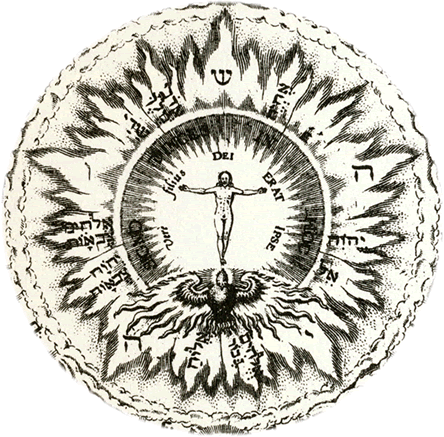 If the late fourteenth and fifteenth centuries are largely identified with the Renaissance, the sixteenth century is frequently associated with the Reformation. The idea of Reformation has a long pedigree in Judeo-Christian thought. Cyclical concepts of history are very ancient and cycles would involve Reformation of a decadent system. Cyclical history does not mesh very well with Christianity’s view of a linear path in history from the fall of humanity in Eden to the redemptive sacrifice of Christ to the second coming and the end of the world.
Despite this seeming conflict, Christianity did adopt a concept of reformation as reflected through its cycles of regeneration and revitalization of the institutions of the Church. Before the Reformation of the sixteenth century, the Church had experienced many reform movements and had managed to incorporate them in a way that revived the Church and maintained its basic unity. The Cluniac reforms, the Gregorian reforms of the twelfth century, and the abortive concilliar reforms of the fifteenth century are all examples.
Let Us Return to Pristine Purity
Interestingly, Luther and Calvin never employed the word Reformation in their writings in the sense that they were creating something new. Instead, they viewed themselves as restoring the Church to its original and true pristine state of Apostolic purity. They did not want to create a new church or a separate church. Instead, they sought to evangelize the existing Church and get it back on track.
It was not until the seventeenth century that the term Reformation started to be applied consistently to Luther and his
 movement. In 1617, the centennial of Luther’s Ninety-Five Theses, Lutherans applied the term Reformation exclusively and uniquely to the achievements of Martin Luther and how he and his followers saved the church from false teachings. The first person to take this concept of Luther’s career and use it as a historical designation was the Lutheran historian Veit Ludwig von Seckdorf (1626-1692). Calvinism was excluded from this view of the Reformation.
movement. In 1617, the centennial of Luther’s Ninety-Five Theses, Lutherans applied the term Reformation exclusively and uniquely to the achievements of Martin Luther and how he and his followers saved the church from false teachings. The first person to take this concept of Luther’s career and use it as a historical designation was the Lutheran historian Veit Ludwig von Seckdorf (1626-1692). Calvinism was excluded from this view of the Reformation.
During the eighteenth century, historians began to use the term Reformation in its modern sense as a designation of the entire era and all its manifestations. Also, multiple named Reformations have proliferated, e.g, the Prince’s Reformation, the Popular Reformation, the Radical Reformation, the Long Reformation, and the Plural Reformations.
Since Seckendorf’s time, historians have come to recognize how the Renaissance and the Reformation are separate from each other but also complement each other. The Renaissance was a cultural rebirth and the Reformation was a religious restoration. The phenomenon of Christian Humanism links them and gives them a continuity which lasted until well into the seventeenth century. As the prominent historian Lewis Spitz (d.1999) suggested in his The Protestant Reformation (1985), the Renaissance and the Reformation form the twin cradle of modernity and constitute one of history’s most significant eras.
Reform and Rejuvenation
The Renaissance contributed to the beginning of individualism and secularism. It also influenced several other key aspects of reform and rejuvenation:
1) The breakup of the unity of Christendom;
2) The introduction of religious pluralism;
3) The development of national churches;
4) The further growth of national monarchies;
5) The dramatic expansion of European influence in the world, setting the stage for future European domination.
To complete the basic elements of modernity, all that was needed was the development of seventeenth-century science and rational philosophy.
Historians also use the term “Early Modern” to refer to the eras known as the Renaissance and the Reformation. Early Modern is a rather fuzzy concept. Its beginning date varies from one group of historians to another.
Some historians take the early modern era back as early as 1300. The problem with that early dating is that it is very difficult to see a significant distinction between European society before 1300 and after. Others tend to see the beginning of the Early Modern era as starting sometime during the fifteenth century, most commonly sometime between 1450 and 1500.
How Do We Define Modernity?
The end of the Early Modern era is also debatable. Some historians would end the Early Modern age around 1700, but most view the end of the Early Modern era as the eruption of the French Revolution in 1789.
The idea of “early modern” has its detractors as well. It is a label that basically claims a specific period of time as the early part of the Modern Era, a time that possessed the characteristics of being “modern.” Modern or modernity is defined as possessing these traits:
1) Secularization
2) Rationalization of political life
3) Rationalization of economic life, e.g., capitalism
4) Industrialization
5) Accelerating urbanization
6) Differentiation of social structures, e.g., the appearance of the modern class structure
7) Increasing democratization
Others, like Jacob Burkhardt, would add the trait of individualism, although some thinkers and historians consider modern industrialized society to be a mass society that is a threat to individualism.
For many historians, if the above list of traits is what constitutes modernity, then what they see during the fifteenth, sixteenth, and seventeenth centuries is a whole lot of the Medieval. The nineteenth-century historians who were Burkhardt’s contemporaries saw Christopher Columbus, Prince Henry the Navigator, and Martin Luther as pioneers and founders of modernity. Beginning in the last third of the twentieth century, historians have increasingly seen Columbus, Prince Henry, Luther, and others as essentially Medieval people.
The dilemma is that historians need the idea of periodization to divide history into manageable segments which hopefully have some coherence. While there is plenty of room for debate among historians on how to periodize history, the fact is, in a broad sense, periodization works. There is a good consensus of periodization by historians, even when they disagree about the details. They see an identifiable Renaissance and an identifiable Reformation. Agreement about the use of early modern is not as strong, but that is a function of its fuzziness as a concept.
For now it is time to move on and see how the revival of the Classics and the rise of Christian Humanism impacted European society. That is another story to be told on another day.

|
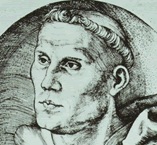
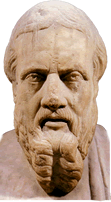

 out that there were earlier renaissances or revivals of culture that were equally important. The renaissance of the Carolingian period during the reign of Charlemagne in the early medieval period has been closely studied. Even more significant is the renaissance of the twelfth century that the medievalist Charles Homer Haskins brought to prominence.
out that there were earlier renaissances or revivals of culture that were equally important. The renaissance of the Carolingian period during the reign of Charlemagne in the early medieval period has been closely studied. Even more significant is the renaissance of the twelfth century that the medievalist Charles Homer Haskins brought to prominence. antiquity. Petrarch believed that history consisted of two eras — the ancient or pre-Christian era and the “nova” (modern) or Christian era. This concept is not unique to Petrarch. It goes back to the worldview of the early Christian Church and was popularized by St. Augustine of Hippo. In the view of Petrarch, the ancient era was a period of solid cultural achievement while the modern era, including his own time, was an age of human and cultural decline.
antiquity. Petrarch believed that history consisted of two eras — the ancient or pre-Christian era and the “nova” (modern) or Christian era. This concept is not unique to Petrarch. It goes back to the worldview of the early Christian Church and was popularized by St. Augustine of Hippo. In the view of Petrarch, the ancient era was a period of solid cultural achievement while the modern era, including his own time, was an age of human and cultural decline. 

 movement. In 1617, the centennial of Luther’s Ninety-Five Theses, Lutherans applied the term Reformation exclusively and uniquely to the achievements of Martin Luther and how he and his followers saved the church from false teachings. The first person to take this concept of Luther’s career and use it as a historical designation was the Lutheran historian Veit Ludwig von Seckdorf (1626-1692). Calvinism was excluded from this view of the Reformation.
movement. In 1617, the centennial of Luther’s Ninety-Five Theses, Lutherans applied the term Reformation exclusively and uniquely to the achievements of Martin Luther and how he and his followers saved the church from false teachings. The first person to take this concept of Luther’s career and use it as a historical designation was the Lutheran historian Veit Ludwig von Seckdorf (1626-1692). Calvinism was excluded from this view of the Reformation.